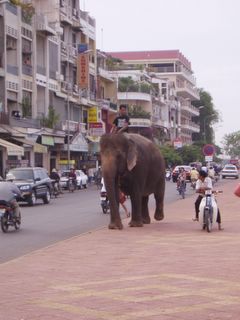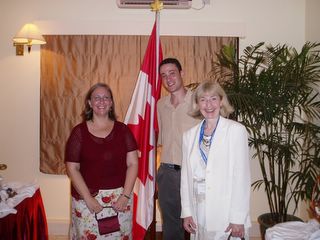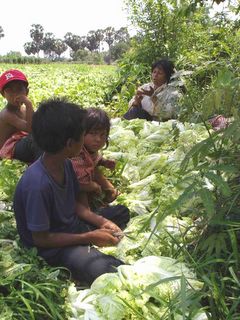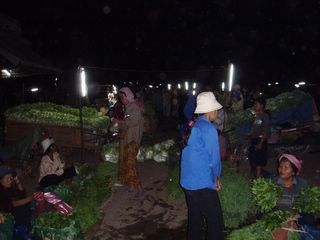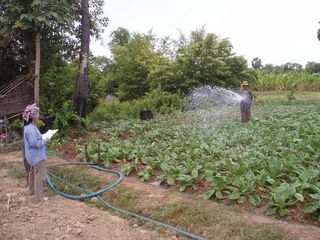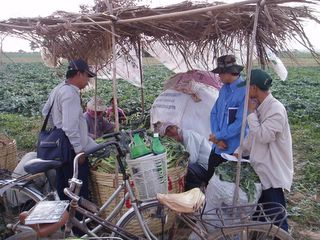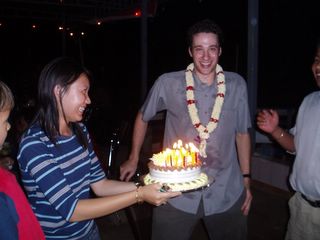Some Lighter Stuff
A lot of things have been happening here recently. Unfortunately, one difficulty of an interesting life is a lack of time with which to write about it. With that in mind, here are a couple of quick anecdotes to carry you through the week…
(For those of you sending me e-mails this week, I may take longer than usual to reply. Sorry in advance for the delay but I’m hoping to dedicate as much time as possible to analyzing the data from the vegetable transport survey completed last week.)
My Reputation Precedes Me
Two weeks ago, Sideth, one of my co-workers, and I went to the small restaurant a block away from the IDE office for lunch. As we were chatting, waiting for our food, a group of five twenty-something foreigners wandered in. With so many NGOs operating in the neighbourhood, foreigners don’t raise too many eyebrows. A crowd this large, this young, and this obviously not from a single family was a bit unusual though. I must have been staring because Sideth asked, “Do you worry that maybe the other foreigners will see you eat lunch with me and will think you do something wrong…?” Khmer society is pretty strict about unmarried couples.
“No,” I replied, “I just have not seen so many foreigners my age in a long time.”
One of the girls from the group approached our table.
-Excuse me, are you from Canada?
-(Surprised.) Yes…
-Did you by any chance go to the University of Waterloo?
-(Do I know this person?) Yes….
-Were you in Prof. Snyder’s History of Christianity course in Fall 2004?
-(Understanding.) Yes. I was the loudmouth you’re remembering.
I though most of you (especially former classmates) would appreciate that one. Small world eh?
Development Math
Given
Under-Developed Country = Transport animals on major city streets.
South-East Asia = Elephants are transport animals.
Now
Developing Country + South-East Asia = Cambodia
Therefore
Cambodia = Elephants on major city streets.
Hobnobbing Amongst the Elite
Wednesday through Friday last week, my friend Sonya’s mother, Françoise, was in Phnom Penh participating in a conference of the Agence Universitaire de la Francophonie, an organization promoting cooperation amongst French speaking universities throughout the globe.
The visit was a fun one. On the first day, she brought me maple syrup from home and I took her for lunch at a nice restaurant in town whose profits go to sheltering and educating street youth. On the second day, she invited me along to a reception being held at the Canadian Ambassador’s residence.
I did my best to dress appropriately, tucking in my shirt, wearing hiking boots instead of sandals, and briefly brushing my hair. It was the best I could do. On the way out the door, my neighbour, Sotha, noticed my efforts. “You look pretty,” he commented. “I go to eat dinner with a big person,” I responded. It was the best explanation I could manage in Khmer.
Unfortunately, in Khmer meeting a big person generally implies a government minister or equivalent. Sotha was a little surprised. I back-pedalled. “No, no. My friend from Canada. Her mother come to Phnom Penh. She know big person from Canada. She say to me, please you come to dinner. Will be around forty people there. I don’t know Cambodian big person. These Canadians sort-of big people.” Sotha looked at me strangely, asked when I’d be home, and called over one of his fellow moto drivers to take me where I was going.
I met Sonya’s mother at the Hotel Intercontinental, a five star, Western-style hotel, where she and several of her fellow delegates were staying. As a police escort with sirens blazing led our francophone minibus through the streets of Phnom Penh, I began to think that perhaps my description to Sotha hadn’t been as inaccurate as I’d thought.
The ambassador was waiting to greet all of the delegates at the door. My brief culture shock at the Hotel Intercontinental was as nothing to my shock on entering her home. It looked and felt exactly like a middle class dwelling in Canada. The differences in the construction, decorations, and furnishings were subtle but overwhelming. It took me a few minutes just to orient myself. Sonya’s mother was extremely helpful and made it her mission that evening to help me establish as many contacts as possible, bringing over new people to meet me every few minutes.
I spent the evening brushing up on my schmoozing skills, in conversation with university administrators, ex-pats, and eventually the ambassador herself. She was very friendly, stopping to offer me some good advice about pharmacies in Phnom Penh. I left that evening as I’d entered, surrounded by a police motorcade, richer by one ambassador’s business card, and hopefully having left a good impression of EWB with a variety of university bigwigs.
